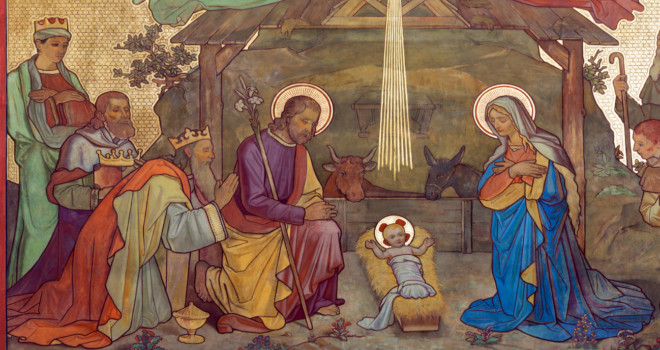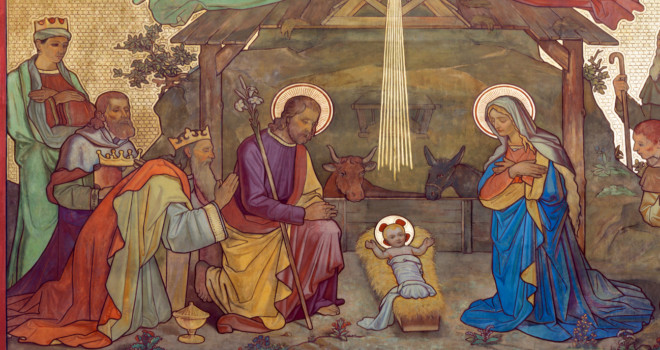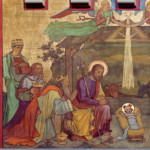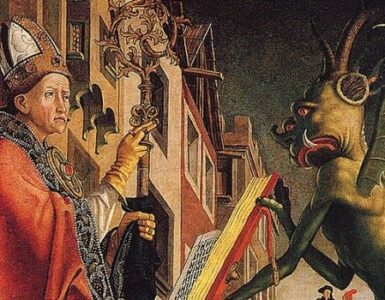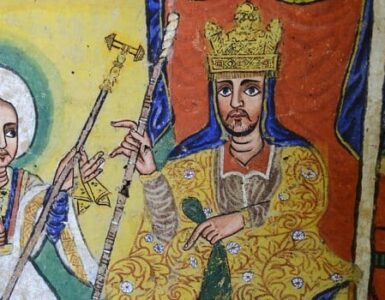After the presentation of Jesus in the Temple, Saint Joseph returned with Mary and the divine Child to Nazareth (Luke 2:39). Most probably, however, the Holy Family journeyed to Bethlehem again with the intention of abiding there permanently. For was not Bethlehem really the birthplace and home of Jesus? It lay, moreover, near Jerusalem, a condition that was an advantage to the Holy Family in many ways. Later on, too, when they had returned from Egypt, Saint Joseph again had in mind to settle down in Bethlehem.
The Holy Family had probably spent about a year in Bethlehem when quite unexpectedly there arrived at Jerusalem strangers, Wise Men from the Orient. With their blunt question as to where the newborn King of the Jews was to be found — for they had seen His star in the East and had come to adore Him — they threw Herod and the whole city with him into a fit of excitement and terror. Herod, the aged, bloodthirsty tyrant in the fortress of David, found no better expedient in his perplexity and crafty dissimulation than to inquire of the Sanhedrin concerning the birthplace of the Messiah. He communicated the answer to the Wise Men, that Bethlehem was the objective point of their quest, and bade them go thither in search of the Child; when they had found Him, they were to let him know so that he, too, might go to adore Him. Thus the Magi reached Bethlehem under the guidance of the star, which to their heartfelt joy had again appeared to them on their departure from Jerusalem.
The country from which the Wise Men came was situated to the east of Judea. They were noblemen, Magi, perchance tribal rulers in possession of the sacred books. It had been intimated to them from on high that, when a certain extraordinary luminary made its appearance in the firmament, they were to proceed from their homes to offer their respects to the newborn King and Messiah. The star did, in fact, appear at the time of the Savior’s birth or later, and they regarded it as their life’s chief endeavor to follow the Heaven-sent guide. This much, at least, the star’s appearance over the manger of the Savior leads us to infer regarding their innermost purposes. Thus, they arrived at Bethlehem and found the Child’s abode pointed out to them by the star as though by a finger of fire.
Together with their servants and beasts of burden they likely took quarters at the khan of the town, and then sent to the Holy Family to inquire if they might be allowed to visit them, for they had come under the guidance of a star to adore the Child. Saint Joseph received the servants in his own gracious manner. And now the kings themselves appeared with their attendants, the latter bearing precious gifts that they had taken from the chests and saddlebags; for in the Orient, custom has it that no one shall come into the presence of a prince empty-handed. Our Blessed Lady, who had in her simple and accommodating way prepared for their reception, held the divine Child in her lap. At the sight of the holy Infant the kings prostrated themselves in a circle before Him; and with profound faith, reverence, and humility, with their hearts’ innermost love and joy, they adored Him and offered Him both themselves and all their subjects.
Possessed of a noble and discerning spirit and truly royal hearts, they were not disturbed at the unacquaintance with the Child prevalent in Jerusalem, or at the simplicity and poverty of the dwelling of the Child and His parents. They cared very little for outward show and followed only the dictates of their simple hearts and of their faith as God had taught them. Thus, in the same spirit they took the gifts that the attendants had arranged in precious caskets on the carpet, and presented them to the Child — gold, frankincense, and myrrh. Gifts pregnant with mystery they were, symbolizing their own hearts’ disposition, their faith, love, and adoration, and typifying the Child’s divinity, royalty, and office of Redeemer.
The divine Infant Savior looked kindly upon the scene before Him, knew full well the meaning of the gifts, and returned all with an outpouring of graces for them and their subjects, and blessed them as the advance guard and firstfruits of the Gentiles. Quite likely the Magi then sat down and conversed with the Mother of God and Saint Joseph, who in admirable simplicity entertained them by relating to them the more intimate circumstances of our Savior’s coming. This is the first occasion on which the Mother of God instructed the heathen world, and Saint Joseph shared in the instruction. The Magi became Christians and brought the true Faith into their own countries.
Thus did they depart from the Child and Mary and Joseph with expressions of intense gratitude and heartfelt contentment and joy. They did not, however, return to Jerusalem. During the night they received in a dream the divine command to avoid Jerusalem on their journey homeward, for Herod had determined upon the ruin of the child. And so, the very same night, they with their retinue directed their steps southward along the way that leads across the Jordan. What they had seen, learned, and experienced was worth all their trouble. They had fulfilled their life’s work.
Mary and Joseph rejoiced exceedingly at this remarkable visit of the Wise Men. Saint Joseph took a keen delight and pleasure in these holy men whose dispositions so much resembled his. He rejoiced above all for Mary’s and his beloved Child’s sake. Great honor had been shown to them. The wisdom of the Orient had come to do homage to the divine wisdom of this speechless Child. How gloriously the kingship of this apparently helpless Babe revealed itself. Hardly is He born and He begins to rule; although poor, He acquires gold and riches and calls His servants and adorers from distant lands; Heaven and earth obey Him, and His advent strikes terror into the hearts of His enemies.
This event is the Tabor of Christ’s infancy. May not Saint Joseph have thrilled with ecstatic joy and said in the words of Saint Peter: “It is good to be here, here we shall build three tabernacles” (see Matt. 17:4)? Who, moreover, does not discern in this mystery of the Gentiles’ vocation a reference to and a type of the call of Saint Joseph to be the patron of heathen missions?
The exalted position Saint Joseph occupied in this mystery, which itself is a presage of the future glorification of the Church of the Gentiles, is most exquisitely and successfully expressed in a thirteenth-century mosaic at Notre Dame in Paris, in which the saint is depicted in a separate compartment under a canopy, resting on his staff in an attitude of meditation and apparently in readiness to receive his own proper homage from the Wise Men. A later painter of intense feeling, Fra Angelico, portrays Saint Joseph actually engaged in familiar conversation with one of the kings and earnestly intent on instructing him in the Faith. In another painting by the same heavenly gifted artist, Joseph, delighted at its costliness, is shown opening one of the caskets containing a royal present that he may offer it to the divine Child as a token of the whole Gentile world, of which Saint Joseph is the patron.
✠
Editor’s note: This article is adapted from a chapter in Fr. Meschler’s book The Truth about Saint Joseph: Encountering the Most Hidden of Saints. It is available from your favorite bookstore or online through Sophia Institute Press.
We also recommend the book The Silent Knight: A History of St. Joseph as Depicted in Art.
image: Fresco of Adoration of Magi, Kostel Svateho Cyrila Metodeje (Prague) by Gustav Miksch and Antonin Krisan, photo by Renata Sedmakova / Shutterstock


